Mistakes and Polishing - Hipster Bike Update 2
Some days are better than others, and those some days are spent either in the garage or on the bike. We recently picked up a 1976 Honda 360T from a music video producer last month and have been spending a lot of time in the garage. We’ve since learned the former ‘builders” (using the term very loosely) had made more than a few mistakes in building this little faux-cafe bike. Intended to be used by my fiancée as her first bike, it needs to be reliable, safe and stylish. Here’s a rundown of the improvements and mistakes we’ve made so far.
READ MORE: I Bought a Hipster Bike | RideApart
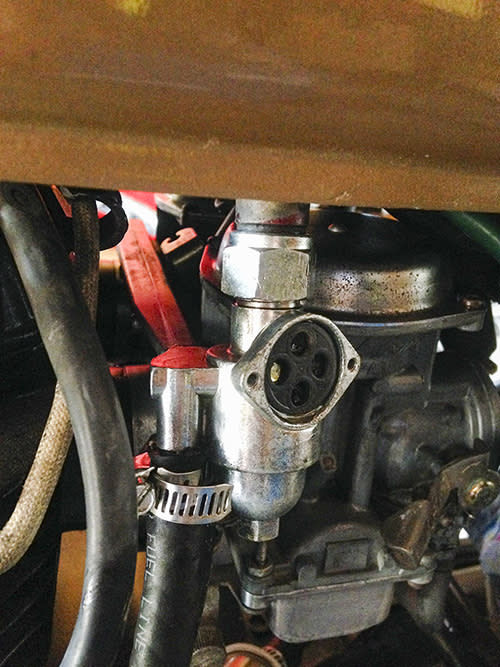
No Fuel = Big Problem
First, we need to answer our trivia question at the end of the first installment: Why wasn't gas coming out of the gas tank?
To answer some of the commenters: NO! It’s not a vacuum-operated petcock!
We did a test ride when we fist looked at the bike. It had been warmed up and was hot and ready to ride when we pulled up (yes, I know I didn’t follow my own advice here).
With pop-on air cleaners in lieu of an air box, it’s probably pulling in too much air. Add that with a straight pipe, it’s a double whammy that often results in an ill running motorcycle.

We kicked it over and it revved to life immediately, idled for a moment, and then died with a faint pop from the exhaust. Another kick and we took off up the road. It felt great while accelerating—it was tuned perfectly with no flat-spot in the RPM range that's usually due to poor tuning and the pop-on-air-cleaner-no-muffler combo. We were pleasantly surprised and thought that the person who built it knew what they were doing.
We were sorely mistaken.
Yes, the quick and faint pop should have been a sign, but we felt it was something fixable. Maybe the carbs aren't perfectly synced or the jets have a little dirt in them. Whatever it was, I figured it could be fixed.
READ MORE: Craigslist Project Bike: How Should We Build It? | RideApart
Once we returned home, we kicked the bike over and took off up the street for a quick ride around the block, a celebratory action I’ve performed many times. The fear of making a bad investment usually blows past you with the same motion of the wind through your hair as you take that first lap around the block. Of course, the bike has to be able to make it around said block.
We made it to the first stop sign and it died. We got it running again, but it wouldn’t accelerate—meaning, as we twisted the throttle, nothing happened. It was obviously struggling for fuel.

We thought to check the bowls of the carbs for dirt that could be clogging the jets. As we pulled them off and began examining, we noticed we forgot to turn off the petcock, even though no fuel was coming out. It was jammed full of brown, clumpy rust that resembled clay mud.
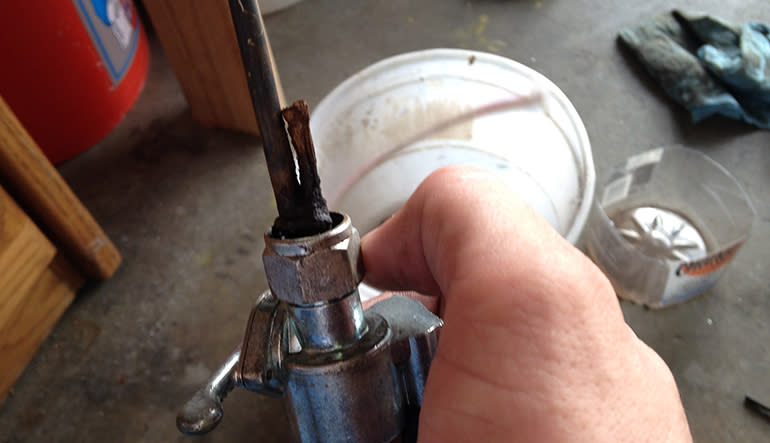
It was blocking the petcock and therefore leaning out the mixture. Just by happenstance, it appeared maybe the fully warmed bike was able to rrun perfectly tuned due to the accidental restriction of fuel from the petcock? Never the less, it needed to be fixed.
We went ahead and cleaned out the little bit of rust that was packed into the bowls, but the jets were luckily clean.
The seller mentioned the bike was shipped from Tennessee to California for re-shoots of the music video it was originally purchased for. My best guess would be that the tank was drained (as some transportation companies insist on no fuel.) The tank was probably left empty as re-shoots were rescheduled many times and then eventually canceled. This eventually introduced rust into the tank. Then, by adding fuel probably hours before we arrived, that rust turned to mud.
We washed out the tank with water and cleaner (we’d stolen a little from our tank sealer kit we used on the Craigslist project bike). We let it sit in the sun for half a day, then blew it out with an air hose and finally a bottle of Heet water-remover with fuel. We did a better job of drying out our Craigslist project bike tank, by duct taping a shop-vac in reverse on high for 20 minutes.

Battery
For kick-start and most older small-CC motorcycles, only the taillight and horn are powered directly from the battery. The headlight is powered by the charging system—this is a safety issue. Let's say you're at a stop light in the middle of nowhere, at night and you stall, the taillight will remain bright, keeping you from getting rear ended.
So, for our 360 with no electric starter, we only needed a few amps. We went to our local battery shop and picked out a compact powersports battery. Dry, sealed and only 18 bucks, it was perfect—we can mount it on its side and under the seat while keeping the opening in the frame free of clutter.
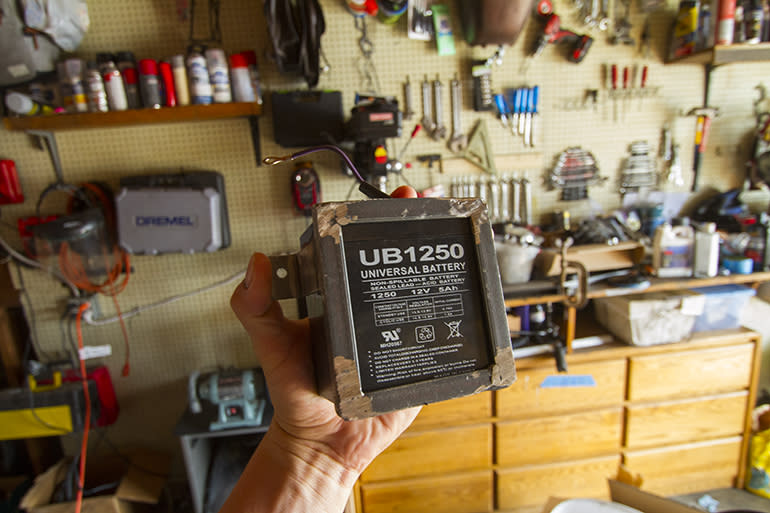
We made our own battery box from angle iron we picked up at McMaster-Carr.
Something caught our attention when we started to clean up the wiring. The ground cable was made up of different color speaker wires (um, that’s odd.) We started untangling the wires to find what we were anticipating. The wires were simply twisted together and then covered in tape (damn it!) That doesn’t worry us as now it’s fixed, but it causes us to wonder what other stupid mistakes did they make?
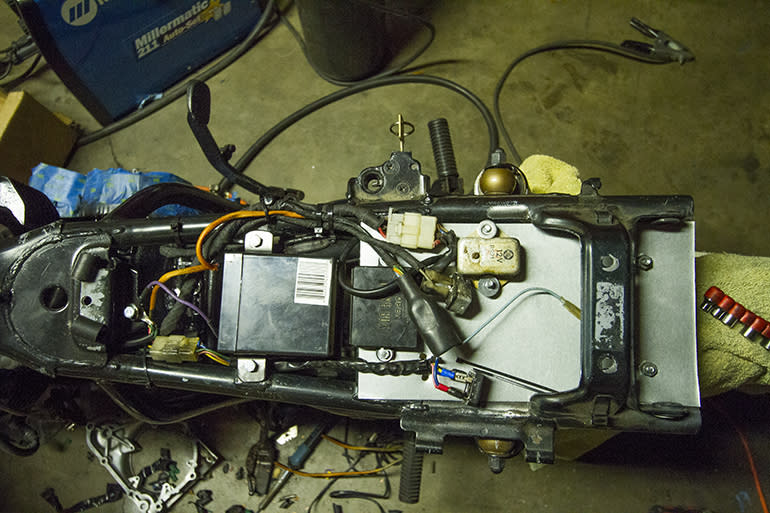
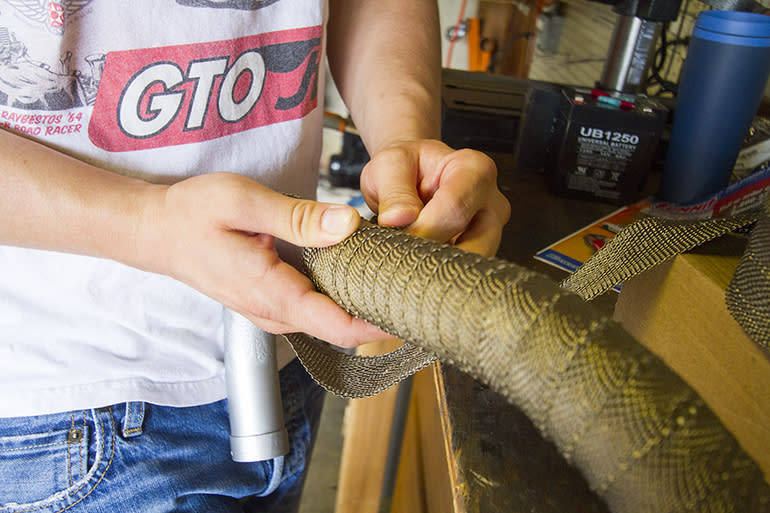
Exhaust
You know Summit Racing? The catalog mailer every gear head has beside the toilet? They have a motorcycle-parts division named Power Sports Place. Setup like Summit, they feature a bunch of universal performance parts along with brakes, cables, gaskets, etc. We picked up 100ft of Volcano exhaust wrap, to eventually be used on our other projects.
Summit Racing $74.97/100ft: Volcano exhaust wrap
Summit Racing $24.97/25ft: Volcano exhaust wrap (Probably only need 25 feet $24.97)

 Yahoo Autos
Yahoo Autos 
